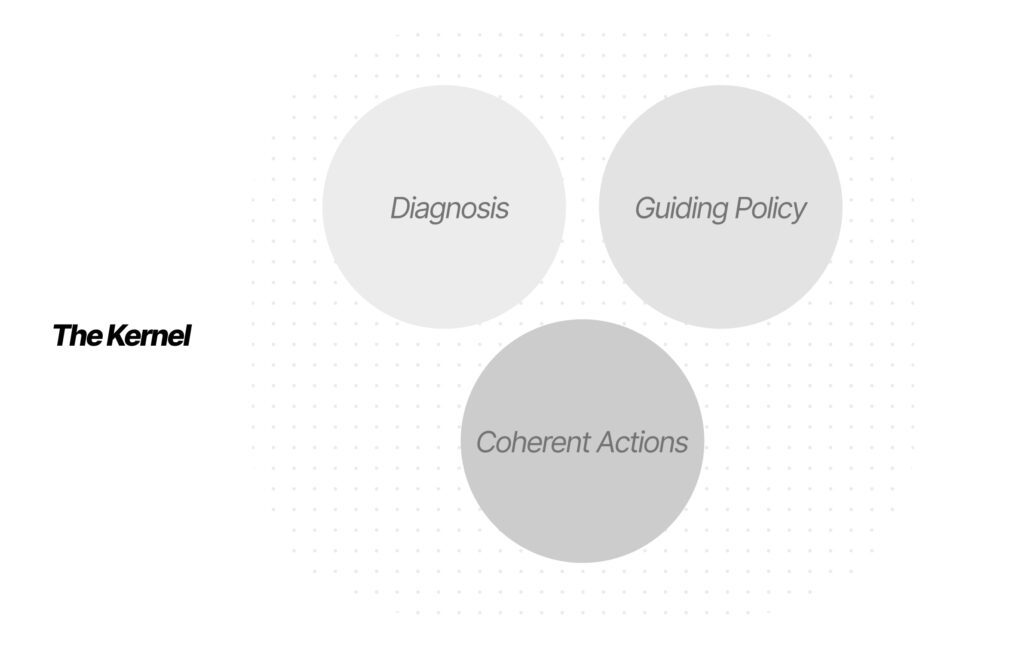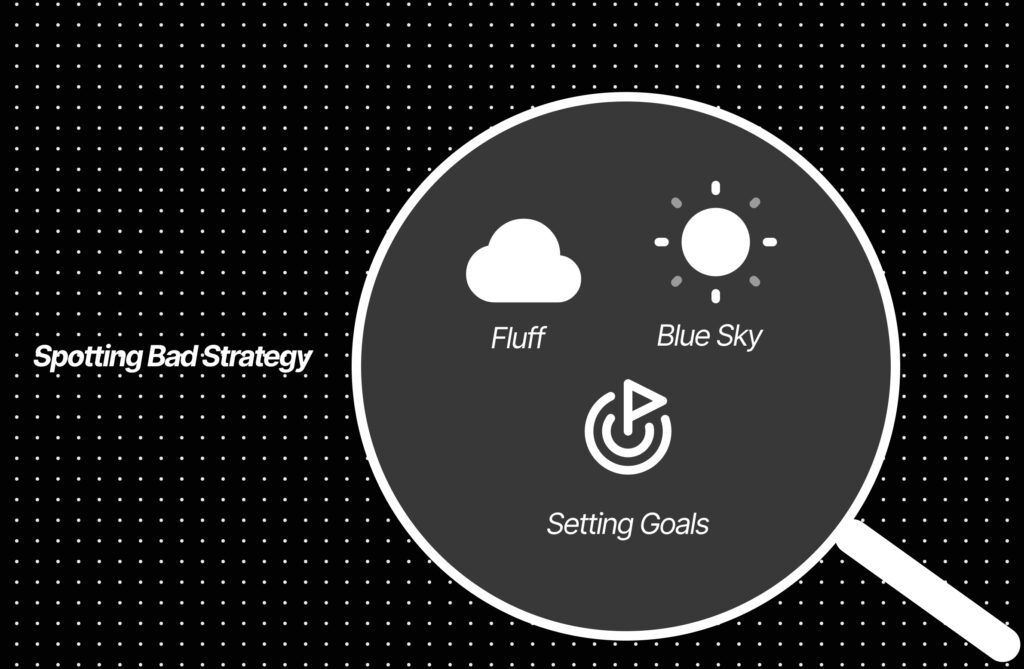Think of strategy as a framework to problem solving composed of three things…
Strategy is the design of a plan that is created to overcome a specific challenge with a chosen ideal outcome. Think of strategy as a framework to problem solving composed of three things, called the kernel:

First you need to understand the true problem at hand. Not the surface level symptoms of a problem. Asking yourself, “What is happening?” to understand the true nature of the challenge.
Your guiding policy is a principle and statement of your approach to solving the problem you discovered in your diagnosis stage. It is your guidepost to what actions will follow.
Coherent actions are quite simple. The actions you take to align with your guiding policy to solve the diagnosed problem. These aren’t a to-do list, but actions that you consistently take to solve the problem.
Anything outside of this framework above is not strategy. But it might be something else…

If your strategy is anything other than the framework provided above, you might have a bad strategy. See if you can spot your bad strategy pitfall below.
Fluff is a common pitfall of bad strategy. The use of jargon and unnecessary language to define your strategy. Typically with buzzwords that don’t have any literal application.
Such as:
“To be a global customer-centric firm .”
“To champion this industry with innovative solutions”
What do those statements actually define as their plan, what are they actually saying? Does it define the literal work, or direct application of such?
Strategy is not a to-do list. It is a three-fold process of uncovering a challenge and solving it. Coherent actions make up ⅓ of your strategy, and they have to align with your guiding policy and diagnosis to work.
The goal is the ‘what’ that you want to achieve, your strategy is your ‘how and why’ you’re going to achieve it.
A company might say:
“Our strategy is to have 10x the revenue by 2027.”
But it misses the foundation of how they are going to do that, if that is even reasonable to be done, and why it matters to have that revenue increase by that much. This objective is called a ‘blue sky objective’, where you pick random numbers, goals and ideas that are baseless and set them as your directive plan.
Often leading to a frustrated company not understanding why they aren’t hitting the objective they set, because they forgot to understand if their industry has that size capacity.
But don’t worry if this is you. You can implement a good strategy easily.
Getting past pitfalls of bad strategy is step one, step two is knowing how to implement a good strategy.

Here are some questions to ask yourself to implement a good strategy, and what to be careful of when doing it. Great for when you’re facing a challenge, need to grow, or have a goal you’d like to achieve.
Ask yourself:
What is happening to cause this challenge?
Why is it happening?
What problems surround this challenge?
Be Careful:
Avoid staying surface deep, ask yourself why once you reach a solution until you land at the core.
What It Looks Like:
Wells Fargo’s revenue was flatlining… because they did not have enough services and products for their bank tellers to sell to their existing customer base.
Ask yourself:
How do I solve the problem diagnosed above?
What solution(s) will decrease the odds of this challenge happening again?
Be Careful:
Avoid creating a step by step plan. A guiding policy should be a single statement of how you will solve the problem at hand.
What It Looks Like:
Wells Fargo’s guiding policy to their revenue problem above would be something like: implement new financial products and services that empower our bank tellers to sell to our existing customer base with more opportunities than just their checking and savings accounts.
Ask yourself:
What are the technical behaviors required to complete the policy above?
Be Careful:
Try not to create a to-do list. This is an organized collection of behaviors created to solve a specific problem. If the action does not align with the problem being solved, eliminate it.
What It Looks Like:
Creating different credit cards for different needs and lifestyles to sell. Offering different loan types for all customer types. Creating services for finance management, such as investment management.
By following this structure, you can implement a good strategy to overcome a challenge. All strategies are subject to change and testing as your business and industry evolves. And it might not always work- because a strategy is the design of solving a problem.
You might incorrectly diagnose the problem, and create guiding policies that are not actually what you need to solve your challenge as a business. Evolution and testing will be key as you learn to implement good strategies in your business to grow.